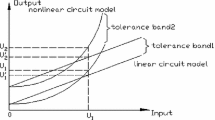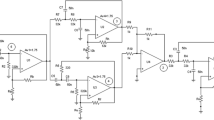Abstract
Aiming at the problem to diagnose incipient faults in weak nonlinear analog circuits, an approach is presented in this paper. The approach calculates the fractional Volterra correlation functions beforehand. The next step is to use the fractional Volterra correlation functions and different angle parameters of the fractional wavelet packet transform (FRWPT) to extract the fault signatures. Meanwhile, the computational complexity is analyzed. Then the variables of the fault signatures are constructed, which are used to form the observation sequences of the hidden Markov model (HMM). HMM is used to accomplish the fault diagnosis. The simulations show that the presented method can significantly improve the incipient fault diagnosis capability.













Similar content being viewed by others
References
O. Akay, G.F. Boudreaux-Bartels, Fractional convolution and correlation via operator methods and an application to detection of linear FM signals. IEEE Trans. Signal Process. 49(5), 979–993 (2001)
F. Aminian, M. Aminian, H.W. Collins, Analog fault diagnosis of actual circuits using neural networks. IEEE Trans. Instrum. Meas. 51(3), 544–550 (2002)
M. Aminian, F. Aminian, Neural-network based analog circuit fault diagnosis using wavelet transform as preprocessor. IEEE Trans. Circuits Syst. II 47(2), 151–156 (2000)
J.W. Bandler, A.E. Salama, Fault diagnosis of analog circuits. Proc. IEEE 73(8), 1279–1325 (1985)
M. Catelani, A. Fort, Soft fault detection and isolation in analog circuits: some results and a comparison between a fuzzy method and radial basis function networks. IEEE Trans. Instrum. Meas. 51(2), 196–202 (2002)
Y. Deng, Y. Shi, W. Zhang, An approach to locate parametric faults in nonlinear analog circuits. IEEE Trans. Instrum. Meas. 61(2), 358–367 (2012)
C. Evans, D. Rees, L. Jones et al., Periodic signals for measuring nonlinear Volterra kernels. IEEE Trans. Instrum. Meas. 45(2), 362–371 (1996)
X. Fan, Y. Zhu, Study on fault phase selection based on FFT and phase-separation current phase difference of high-voltage transmission lines, in ICMA (2010), pp. 762–767
G.O. Glentis, P. Koukoulas, N. Kalouptsidis, Efficient algorithms for Volterra system identification. IEEE Trans. Signal Process. 47(11), 3042–3057 (1999)
G.H. Golub, C.F.V. Loan, Matrix Computations, 3rd edn. (Johns Hopkins University Press, Baltimore, 1996)
Z. Huang, C. Liu, R. Liu, Node fault diagnosis and a design of testability. IEEE Trans. Circuits Syst. 30(5), 257–265 (1983)
B. Jiang, P. Shi, Z.H. Mao, Sliding mode observer-based fault estimation for nonlinear networked control systems. Circuits Syst. Signal Process. 30, 1–16 (2011)
B.H. Juang, L.R. Rabiner, Hidden Markov models for speech recognition. Technometrics 33(3), 251–272 (1991)
S.N. Kher, G.M. Bubel, Predicting system-failure risk from unanticipated fiber-breaks in manufacturing. IEEE Trans. Reliab. 47(2), 126–130 (1998)
R. Kondagunturi, E. Bradley, K. Maggard, C. Stroud, Benchmark circuits for analog and mixed-signal testing, in Southeastcon’99, Proc. IEEE (1999), pp. 217–220
F. Li, P.Y. Woo, Fault detection for linear analog IC—the method of short-circuits admittance parameters. IEEE Trans. Circuits Syst. I 49(1), 105–108 (2002)
L. Milor, V. Visvanathan, Detection of catastrophic faults in analog integrated circuits. IEEE Trans. Comput.-Aided Des. Integr. Circuits Syst. 8(2), 114–130 (1989)
A.A.K. Mohsen, M.F.A. El-Yazeed, Selection of input stimulus for fault diagnosis of analog circuits using ARMA model. AEÜ, Int. J. Electron. Commun. 58(3), 212–217 (2004)
W. Nelson, Weibull prediction of a future number of failures. Qual. Reliab. Eng. Int. 16, 23–26 (2000)
O.T. Ogunyemi, P.I. Nelson, Prediction of gamma failure times. IEEE Trans. Reliab. 46(3), 400–405 (1997)
L.R. Rabiner, B.H. Juang, An introduction to hidden Markov models. IEEE ASSP Mag. 3(1), 4–15 (1986)
J. Roh, J.A. Abraham, Subband filtering for time and frequency analysis of mixed-signal circuit testing. IEEE Trans. Instrum. Meas. 53(2), 602–611 (2004)
W.J. Rugh, Nonlinear System Theory—The Volterra/Wiener Approach (Johns Hopkins University Press, Baltimore, 1981)
M. Slamani, B. Kaminska, Analog circuit fault diagnosis based on sensitivity computation and functional testing. IEEE Des. Test Comput. 5, 30–39 (1992)
J.A. Starzyk, D. Liu, Z.H. Liu, D.E. Nelson, J.O. Rutkowski, Entropy-based optimum test nodes selection for the analog fault dictionary techniques. IEEE Trans. Instrum. Meas. 53(3), 754–761 (2004)
S.M. Virk, A. Muhammad, A.M. Martinez-Enriquez, Fault prediction using artificial neural network and fuzzy logic, in The 7th Mexican International Conference on Artificial Intelligence (2008), pp. 149–154
P. Wang, S.Y. Yang, A new diagnosis approach for handling tolerance in analog and mixed-signal circuits by using fuzzy math. IEEE Trans. Circuits Syst. I 52(10), 2118–2127 (2005)
L.J. Xu, J.G. Huang, H.J. Wang, B. Long, A novel method for the diagnosis of the incipient faults in analog circuits based on LDA and HMM. Circuits Syst. Signal Process. 29, 577–600 (2010)
J. Yang, Y.S. Xu, C.S. Chen, Human action learning via hidden Markov model. IEEE Trans. Syst. Man Cybern., Part A, Syst. Hum. 27(1), 34–44 (1997)
S.K. Yang, A condition-based failure-prediction and processing-scheme for preventive maintenance. IEEE Trans. Reliab. 52(3), 373–383 (2003)
S.K. Yang, T.S. Liu, A Petri net approach to early failure detection and isolation for preventive maintenance. Qual. Reliab. Eng. Int. 14, 319–330 (1998)
L.F. Zhou, Y.B. Shi, J.Y. Tang, Y.J. Li, Soft fault diagnosis in analog circuit based on fuzzy and direction vector, in Metrol. Meas. Syst., vol. XVI(1) (2009), pp. 61–75
Acknowledgements
The authors would like to thank the reviewers and the editors for their constructive comments and suggestions.
This work is supported by Program for New Century Excellent Talents in University (NCET-05-0804) and partly supported by Chinese National Programs for High Technology Research and Development (2006AA06Z222).
Author information
Authors and Affiliations
Corresponding author
Rights and permissions
About this article
Cite this article
Shi, Y., Deng, Y. & Zhang, W. Diagnosis of Incipient Faults in Weak Nonlinear Analog Circuits. Circuits Syst Signal Process 32, 2151–2170 (2013). https://doi.org/10.1007/s00034-013-9589-0
Received:
Revised:
Published:
Issue Date:
DOI: https://doi.org/10.1007/s00034-013-9589-0




